
Brown Note Provides Complete Production for July Shows Featuring Peekaboo and Dirt Monkey at Mile High Flea Market
For two consecutive Thursdays in July, concert promoters Feyline and LionShare took over the Mile High Flea Market in Henderson, CO, in the Denver area. Working with the flea market’s owners and L.A.-based Nuell Entertainment, they turned the space into an open-air drive-in facility with state-of-the-art production, setting the stage for a new, bass-heavy EDM concert series concept, Dirty Drive-In.

Show Promotion
Each evening brought live music by a different leading artist from the underground scene, bringing people together by the carload for a safe, social distancing live event, the first in this state.
PLSN caught up with Tyler Fey from Feyline, a longtime concert promoter out of the Denver area, as well as Patrick Dowling and Stephanie Rosa from LionShare to talk about promoting the event. Patrick explains his upstart company. “LionShare is an exciting new brand, launched for the artists’ future in the music industry. Designed as a full-service resource, LionShare is based on a structure to create a comprehensive artist development model. Through strategic alliance, LionShare provides activation points for recording, publishing/syncs, apparel, live production and management with the focus of pairing artists and teams with the right combination to meet desired goals.”
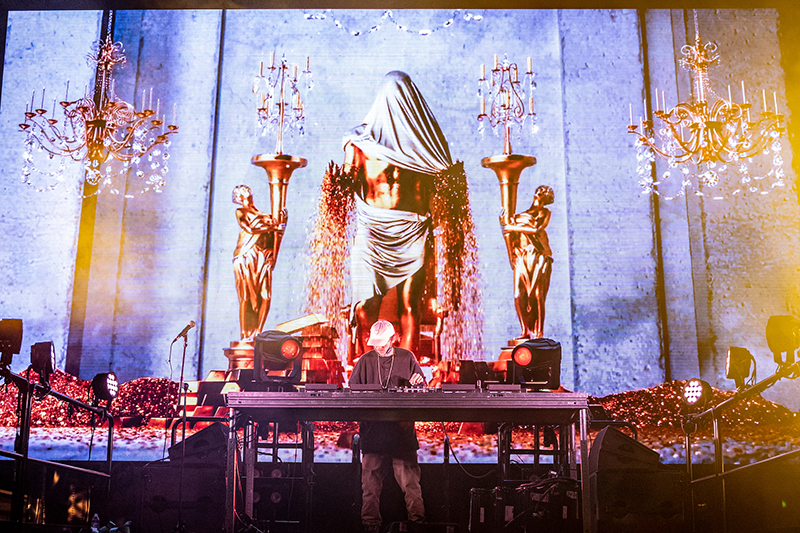
The Fey name has been synonymous with promoting live music forever. When quizzed about how the idea for this event came up says Fey, “I was asked by a close friend in the industry if Feyline was going to pursue the Drive-In model in Colorado or anywhere in the states. I told her if she wanted to, she could absolutely run with the model with my team and partners, and so the process began. The name, Dirty Drive-In, was me, I think. Many of the fans in the bass scene refer to this type of music as ‘dirty,’ so that’s where it was derived. The idea to book out each Thursday was our team wanting to bring as much music as possible to the fans and get as many artists working as possible.” Fey notes that “these were LionShare’s first shows, but Patrick and I are partnered in LionShare 360, where one of the divisions is Live.”

These shows came together rather quickly with the help of the promoter’s solid team and Brown Note conceptualizing an awesome production. Rosa explains the allure of these shows. “Denver is known as the bass capital of the world, so we started building out shows that we had a feeling would do well here in Colorado. We had the first shows booked with bass artists and were planning to conclude the fourth one with feel good, hybrid electronic/instrumentalists Goldfish.”
The plan called for the first two shows, Peekaboo (July 9) and Dirt Monkey (July 16), to be followed by Eprom (July 23) and then Goldfish (July 30), but by mid-July, Colorado, like many states in the South and West, was experiencing a surge in new Covid-19 cases. A mask order was put into effect state-wide, and out of an abundance of caution, the last two shows were postponed.

LionShare is partnered with the label (19K) of the headliners of the July 16 show, Dirt Monkey. This show sold out ahead of time, and drive up’s were turned away. But the July 9 performance with Peekaboo was able to accommodate drive up vehicles on site and sold out day-of. To provide some distance between the cars, every other lane in the parking lot was left unsold and vacant, and attendees were limited to staying within the confines of their vehicles. Fey expands on the setup. “The site was built out for several hundred vehicles, and the parking was laid out to ensure distancing between vehicles. We worked hard to ensure that our customers had a fun experience while being safe and respectful of the guidelines we needed to follow.” Rosa adds to this, “We definitely had people driving up and purchasing tickets in line for Peekaboo. It still made for a safe/contactless experience, since they were provided with a QR code that was scanned upon entry without having to worry about person-to-person contact.”
Fey adds, “For security, we used the great crew over at Liberty Staffing who also works on events such as Cheyenne Frontier Days,” a rodeo event in Wyoming, “and other festivals like Superfly’s Grandoozy.” Audience guidelines included mandatory mask wearing, even before the statewide mandate was issued in mid-July. “We certainly enforced the rule.”
Staying away from the whole tailgate scene, a variety of concessions were available onsite and through the venue. Customers were able to enter with pre-sealed water bottles only. Fey adds, “We referenced the comprehensive NIVA guide to ensure we were following reputable cleaning standards for the porta johns and the venue stands.”
The GA admission price was $198 per vehicle per show. There was no package deal for all four shows, but Fey adds, “the premium viewing and front seats act as the reserved seats on drive-in shows, but as it says on our site, Feyline has always been about everyone being a VIP.”
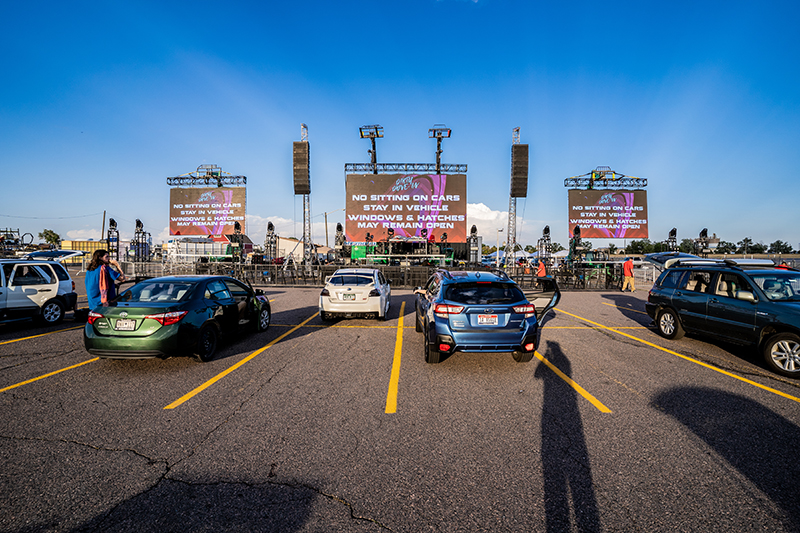
Show Production
Brown Note is an all-service vendor of gear located in the Denver area. Since they could provide all of the staging, video, audio, lasers and lighting, it made perfect sense that the promoters reached out to them, especially with such a short turnaround from the time the event was thought up until it was executed. Brown Note president Ryan Knutson tells us, “This is our first time working with Feyline. We have a lot of mutual friends in the industry, and they had heard of Brown Note. Our full 360 AVL production services proved we were a good fit for their production needs.”
Staging-wise, Brown Note offered up a simple standard deck system they bought from Staging Concepts. Nothing special, just a good ole 16’ x 12’ @ 6’ high model. The stage only had to hold a simple DJ setup. Railings along the side held up some side lights used to illuminate the artist on stage. (Brown Note carries standard as well as custom decking, including plexi and other fun shapes and sizes for their touring and national clients.)
The attendees’ vehicles were spread out fairly wide, and extra video support was brought in for both sides of the stage to provide a good view for all. With no hanging points available, Brown Note took to utilizing four telehandlers (oversized forklifts) to hang the main LED wall upstage as well as the two auxiliary ones on each side. Knutson explains, “We have hung LED and P.A. systems in this fashion before. It’s not an ideal situation, but with budgets and build/strike costs needing to be minimal, they were a perfect solution for our needs.”

The center wall was held up by two chain hoists rigged to the telehandler’s forks. The outside walls were hung directly from the forks. Ryan explains the safety factor involved. “The handlers all have outriggers and are very stable on the asphalt once leveled. We are maintaining a minimum of 2:1 load rating on the center wall and a 4:1 ratio on the two side walls. This was critical for us to feel comfortable with this setup. We are also using load cells on the main large wall to make sure we are well within the weight ratio we desire, and when we land the system, we know how much weight we are taking off the lifts.
“As far as the weight loads go, they are all rated for 10-12K loads. We of course are micromanaging the angle of the mast and the trim height to be within our acceptable load ratio of a minimum of 2:1.”
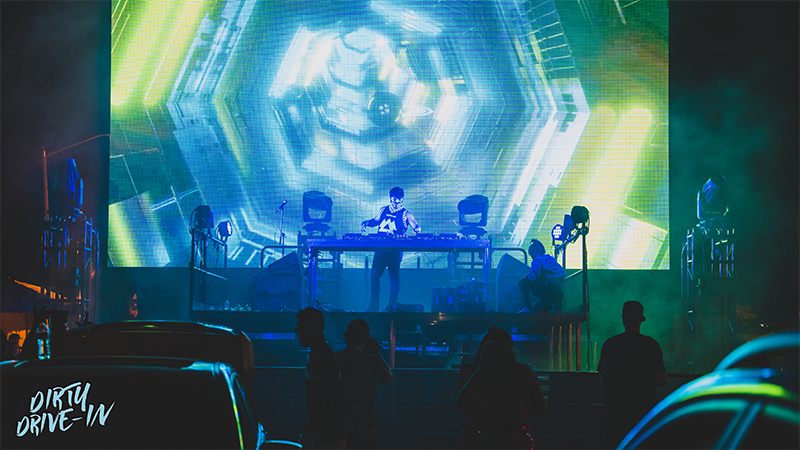
The video tiles in use are all ROE Visual MC-7H products. Due to the fact that the production had to be loaded in day of show (trucks unloaded the day before), they were the obvious choice. Knutson explains Brown Note’s way of operating. “Our MC-7H system comes complete with touring frames for quick assembly, and everything is carted. This is important for any event we do — we rarely use any products without the touring frame unless we are building a custom one- off LED system that does not work well with them.” Knutson makes note that the black SMDs used in this product are outdoor-rated. The ROE Visual products, he adds, are rock-solid. “All of the technology we chose to bring to this gig is IP-rated, as we have no weather protected stage and were planning on leaving all the gear onsite for the run of shows.” With the 110° viewing angle and brightness of these LEDs, “you can see them from about a mile away when you get over the highway. We had to keep the entire production stage footprint within the fire lanes on each side of the parking lot.”
The same video signal was fed to all of the walls, as it was deemed everyone in attendance should be offered the same view. “We have the capability to config this system however we need to, but with very few guest VJ’s, it’s just easier for those guys to step up, plug in and go,” Ryan says. “We have had a few guests running their own content, but mostly it has been our team. Kyle Wolfe, Matt Ardoin and James Watt were behind all that. Three static cameras were located around the stage. The team used three Blackmagic Design Micro studio 4K cameras and a Roland V-800 switcher for the setup.”
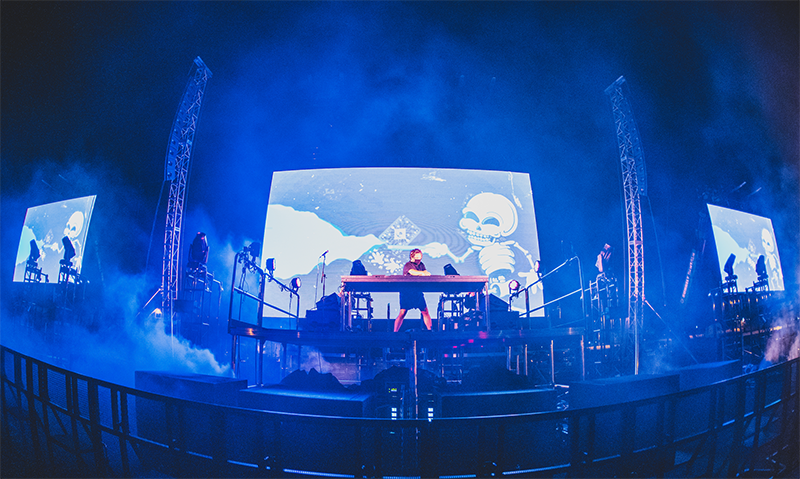
Lighting-wise, the stage setup was minimal, with no flying points available for extra truss and weight. Elation SIXPAR 200IP fixtures provided key lighting for the DJ’s from the sides, with a couple movers backlighting them from positions upstage. The design focused more on an EDM approach and included multiple vertical towers set up on either side of stage. Twelve Tyler GT trusses were held upright on their Tyler floor bases and fitted with Elation IP65 fixtures. A dozen Elation Proteus Maximus fixtures provided impressively bright beams, while Protron Eclypse IP65 strobes and DTW-700s bathed the audience in color while also blinding them at opportune times. “The idea here was to make the load-in and load-out easy, so we pre-rigged the towers so we could roll them into place, flip up, wire, and go,” Ryan adds. “Sean Ginsberg is our grandMA2 operator, and Joe Casper handled the design.”
Doors were at 7 p.m., with the show starting at 8 p.m. The headliners got an additional treat as Brown Note brought in four of their Kvant Spectrum 25-watt lasers from their inventory and mounted them atop certain vertical towers. They were run via Pangolin Beyond software from a separate laptop and an APC40. The lasers were programmed and run by Joe Casper.
Brown Note also supplied the audio, with arrays that hung from Applied Electronics LA16-35 ground support towers, flown just offstage. We asked Knutson how the weather held out for him.” The first week, the weather was windy and we had a few showers. We activated our high wind action plan during some 20 m.p.h. gusts we had, as that massive super cell storm rolled off the front range. It was the biggest one of the year so far in Denver, but luckily it was far enough east that we only caught some of the wind shear. It made for a cool photo, though!”
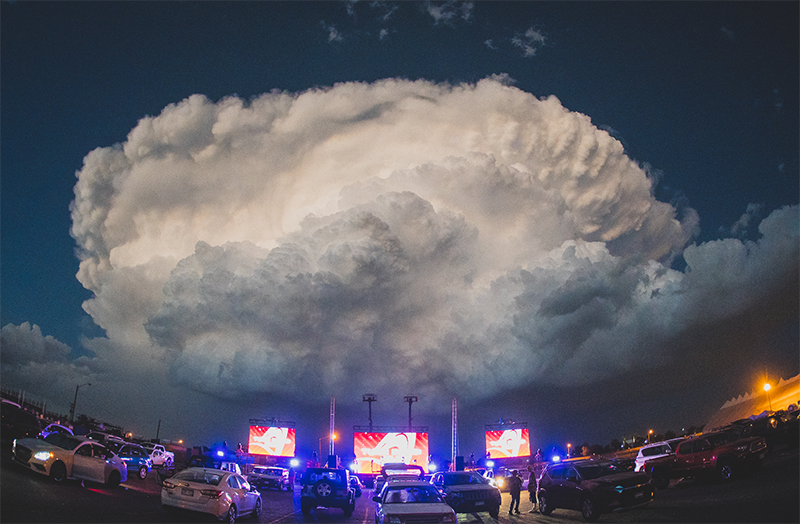
With both shows selling out and deemed a success, the organizers are hoping that the series will continue when things lighten up. In closing, Knutson adds, “It was great to be a part of making people happy again. I think I can speak for everyone at the company that the day after the event was probably the most normal any of us have felt in 18 weeks. It was an honor to be a part of something like this, and to try to save the music, one day at a time.”


